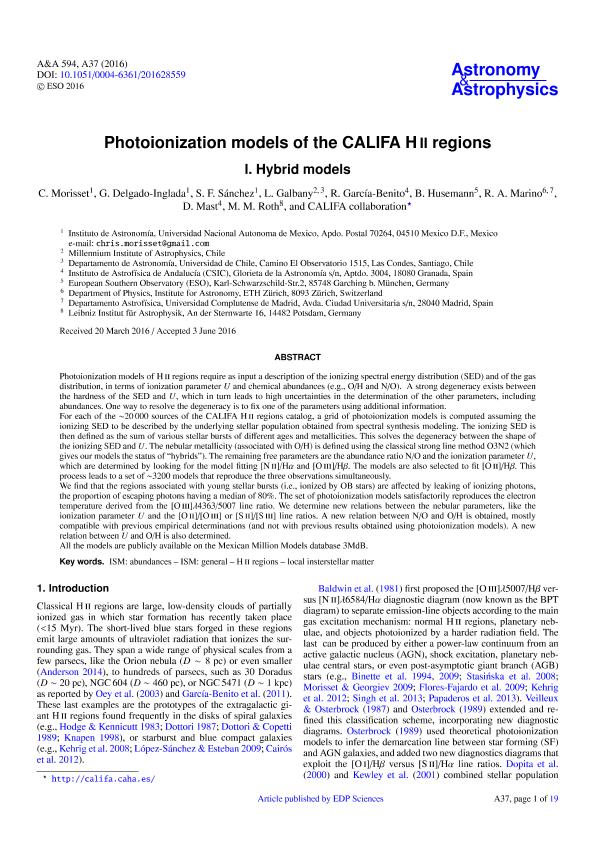Mostrar el registro sencillo del ítem
dc.contributor.author
Morisset, C.
dc.contributor.author
Delgado-Inglada, G.
dc.contributor.author
Sánchez, S. F.
dc.contributor.author
Galbany, L.
dc.contributor.author
Garciá-Benito, R.
dc.contributor.author
Husemann, B.
dc.contributor.author
Marino, R. A.
dc.contributor.author
Mast, Damian

dc.contributor.author
Roth, M. M.
dc.date.available
2019-04-11T16:52:32Z
dc.date.issued
2016-06
dc.identifier.citation
Morisset, C.; Delgado-Inglada, G.; Sánchez, S. F.; Galbany, L.; Garciá-Benito, R.; et al.; Photoionization models of the CALIFA H II regions: I. Hybrid models; EDP Sciences; Astronomy and Astrophysics; 594; 6-2016
dc.identifier.issn
0004-6361
dc.identifier.uri
http://hdl.handle.net/11336/74074
dc.description.abstract
Photoionization models of H II regions require as input a description of the ionizing spectral energy distribution (SED) and of the gas distribution, in terms of ionization parameter U and chemical abundances (e.g., O/H and N/O).A strong degeneracy exists between the hardness of the SED and U, which in turn leads to high uncertainties in the determination of the other parameters, including abundances. One way to resolve the degeneracy is to fix one of the parameters using additional information. For each of the ~20 000 sources of the CALIFA H II regions catalog, a grid of photoionization models is computed assuming the ionizing SED to be described by the underlying stellar population obtained from spectral synthesis modeling. The ionizing SED is then defined as the sum of various stellar bursts of different ages and metallicities. This solves the degeneracy between the shape of the ionizing SED and U. The nebular metallicity (associated with O/H) is defined using the classical strong line method O3N2 (which gives our models the status of “hybrids”). The remaining free parameters are the abundance ratio N/O and the ionization parameter U, which are determined by looking for the model fitting [N II]/Hα and [O III]/Hβ. The models are also selected to fit [O II]/Hβ. This process leads to a set of ~3200 models that reproduce the three observations simultaneously. We find that the regions associated with young stellar bursts (i.e., ionized by OB stars) are affected by leaking of ionizing photons,the proportion of escaping photons having a median of 80%. The set of photoionization models satisfactorily reproduces the electron temperature derived from the [O III]λ4363/5007 line ratio. We determine new relations between the nebular parameters, like the ionization parameter U and the [O II]/[O III] or [S II]/[S III] line ratios. A new relation between N/O and O/H is obtained, mostly compatible with previous empirical determinations (and not with previous results obtained using photoionization models). A new relation between U and O/H is also determined. All the models are publicly available on the Mexican Million Models database 3MdB.
dc.format
application/pdf
dc.language.iso
eng
dc.publisher
EDP Sciences

dc.rights
info:eu-repo/semantics/openAccess
dc.rights.uri
https://creativecommons.org/licenses/by-nc-sa/2.5/ar/
dc.subject
Hii Regions
dc.subject
Ism: Abundances
dc.subject
Ism: General
dc.subject
Local Insterstellar Matter
dc.subject.classification
Astronomía

dc.subject.classification
Ciencias Físicas

dc.subject.classification
CIENCIAS NATURALES Y EXACTAS

dc.title
Photoionization models of the CALIFA H II regions: I. Hybrid models
dc.type
info:eu-repo/semantics/article
dc.type
info:ar-repo/semantics/artículo
dc.type
info:eu-repo/semantics/publishedVersion
dc.date.updated
2019-03-21T14:13:38Z
dc.identifier.eissn
1432-0746
dc.journal.volume
594
dc.journal.pais
Francia

dc.description.fil
Fil: Morisset, C.. Universidad Nacional Autónoma de México; México
dc.description.fil
Fil: Delgado-Inglada, G.. Universidad Nacional Autónoma de México; México
dc.description.fil
Fil: Sánchez, S. F.. Universidad Nacional Autónoma de México; México
dc.description.fil
Fil: Galbany, L.. Millennium Institute Of Astrophysics; Chile. Universidad de Chile; Chile
dc.description.fil
Fil: Garciá-Benito, R.. Instituto de Astrofísica de Andalucía; España
dc.description.fil
Fil: Husemann, B.. European Southern Observatory; Alemania
dc.description.fil
Fil: Marino, R. A.. Universidad Complutense de Madrid; España. Institute for Astronomy; Suiza
dc.description.fil
Fil: Mast, Damian. Instituto de Astrofísica de Andalucía; España. Universidad Nacional de Córdoba. Observatorio Astronómico de Córdoba; Argentina. Consejo Nacional de Investigaciones Científicas y Técnicas. Centro Científico Tecnológico Conicet - Córdoba; Argentina
dc.description.fil
Fil: Roth, M. M.. Astrophysikalisches Institut Potsdam; Alemania
dc.journal.title
Astronomy and Astrophysics

dc.relation.alternativeid
info:eu-repo/semantics/altIdentifier/doi/http://dx.doi.org/10.1051/0004-6361/201628559
dc.relation.alternativeid
info:eu-repo/semantics/altIdentifier/url/https://www.aanda.org/articles/aa/abs/2016/10/aa28559-16/aa28559-16.html
Archivos asociados
